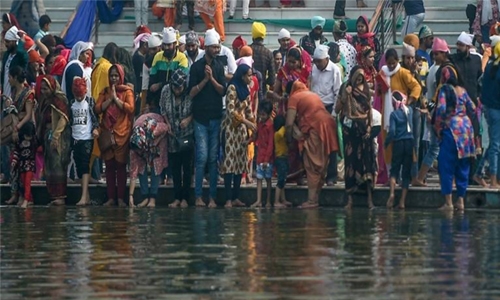Sikhs celebrate founder’s 550th birthday
Sporting saffron and blue turbans and headscarves, hundreds of thousands of devotees braved hazardous smog to pack the city of Sultanpur Lodhi in India for the 550th birth celebrations of Sikhism’s founder Guru Nanak. Guru Nanak, born in 1469 to a Hindu family in a present-day Pakistani city east of Lahore, is believed to have gained enlightenment in Sultanpur Lodhi in the northern Indian state of Punjab, making it one of the key pilgrimage sites for the religion.
People rode on tractors, motorbikes and in cars -- and some even walked barefoot -- to reach the Sri Ber Sahib temple, or gurudwara, where they honoured the Guru with prayers. Others took a dip in a pond on the temple’s premises believed to contain holy water with healing powers. “I’m feeling very blessed to be here. To be with our first guru. I think our first Guru is still present here,” Sukhjeet Singh, a Sikh devotee at the gurudwara in Sultanpur Lodhi, said. “My whole being has been soaked in this spiritual situation.
It’s a very momentous occasion.” The religion’s holiest shrine, the Golden Temple in Punjab’s Amritsar some 70 kilometres (44 miles) from Sultanpur Lodhi, was lined with lights to mark the occasion. Across India, Sikh and Hindu communities prepared feasts known as langars to mark the anniversary. Food is distributed to the community, including the poor. This year’s celebrations took on special significance due to the opening of the Kartarpur Corridor -- a secure land link allowing Indian Sikhs to visit the gurdwara in the Pakistani town where Guru Nanak died.
Sikhism is a monotheistic religion born in the 15th-century in Punjab –- meaning the land of five rivers, a region spanning parts of what is now India and Pakistan. Five and a half centuries later, Sikhs number up to 30 million worldwide, with a rich diaspora in places such as Canada, the US and Europe -- although the vast majority remain in India. Once rulers of the Punjab, they were considered a martial race by the British colonisers. Men, in particular, are instantly recognisable by their colourful turbans, used to cover their hair, which they must leave uncut.
That is one of the five articles of their faith they must carry all the time, known as the Five Ks: the Kesh (uncut hair), Kara (a steel bracelet), Kanga (a wooden comb), Kaccha (cot- t o n underwear), and Kirpan (a curved dagger). Sikhs worship God, known to them as Waheguru, or “wonderful teacher”, inside gurdwaras, or “doorways to God”. The word “Sikh” means the “seeker”, or the “learner”. Male Sikhs bear the name “Singh”, which means lion; while women go by “Kaur”, or princess.
Who was Guru Nanak?
Guru Nanak was the first of ten gurus who developed the Sikh faith and community over the next centuries. Guru Nanak was born in 1469 to a Hindu family at Nankana Sahib, a Pakistani city about 80 kilometres (50 miles) from the eastern city of Lahore. Some legends say there were signs of divinity around him from the start, such as the time a cobra was found rearing over his head -- not to attack him, but to shade him from the sun as he napped.
As he grew older the Guru began travelling, preaching a faith based on equality and one God. He died in 1539 in the Punjabi town of Kartarpur, in modern-day Pakistan, where his remains are buried. Nine gurus followed Guru Nanak and there is no living human successor, but the Guru Granth Sahib -- the Sikh holy book -- is considered the 11th and eternal.
What happens on his birthday?
Sikhs around the world, but especially on the subcontinent, come together to sing, pray, eat and hold sprawling processions to different gurdwaras. Some of the biggest celebrations happened on the site of one of their holiest shrines, the Golden Temple in Amritsar, India.
Why is this year special?
Apart from it being the 550th anniversary, this year also saw the opening of the Kartarpur Corridor -- a secure land link allowing Indian Sikhs to visit the gurdwara in the Pakistani town where the Guru died. The gurdwara at Kartarpur is so close to the India-Pakistan frontier that its white dome and four cupolas can be seen from across the border.
India has long been asking for Sikhs to be given access to Kartarpur, and last weekend their wish was finally granted with the opening of the corridor just days ahead of the birthday celebrations.
Related Posts

